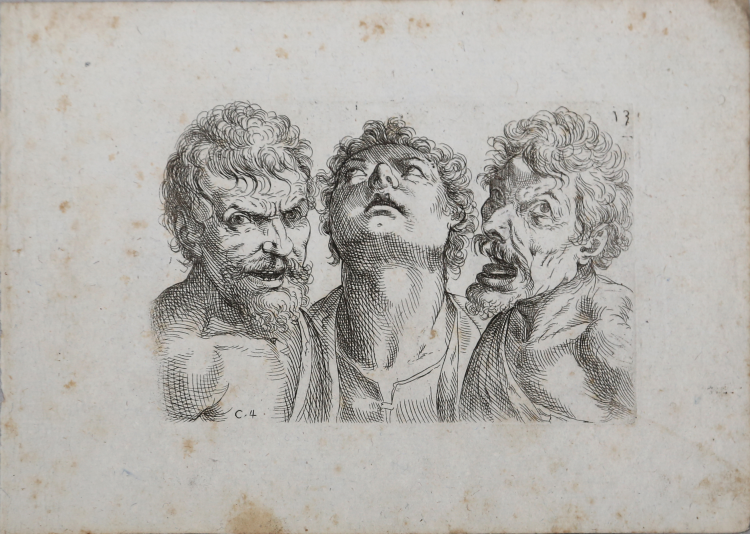




| Reference: | S5353 |
| Author | Odoardo FIALETTI |
| Year: | 1608 |
| Measures: | 170 x 110 mm |



| Reference: | S5353 |
| Author | Odoardo FIALETTI |
| Year: | 1608 |
| Measures: | 170 x 110 mm |
Etching, circa 1608, without signature.
From the series "Il vero modo et ordine per dissegnar tutte le parte et membra del corpo humano", published by Justus Sadeler, in Venice 1608.
A fine impression, with margins, in very good condition.
Odoardo Fialetti was born in Bologna on July 18, 1573, posthumously son of the Doctor Odoardo Fialetti; entrusted to his older brother, this one put him at the school of the painter G. B. Cremonini. Subsequently, at the age of nine years, he moved with his brother first to Padua and then to Venice, where he attended the workshop of Tintoretto. He probably also spent a period in Rome to perfect his artistic studies.
More than for his activity of painter, Fialetti is known for the vast graphic work, today constituted by about 240 etchings in which evident are the elements of Carracci's taste, in particular of Agostino, above all in the search of a balance between the graphic language and the pictorial and coloristic suggestions. The corpus of engravings is very varied in the subjects and includes engravings both of translation and of his own invention. Among the first, two prints should be mentioned, d'après Tintoretto, with a religious subject, Le nozze di Cana (from the painting in the sacristy of the church of La Salute) and a S. Sebastiano; a series of eleven pieces of friezes with trophies on an invention of Polidoro da Caravaggio; four mythological subjects from the frescoes of Pordenone for palazzo Tinghi in Udine; two series of grotesques, with vegetable and animal motifs united with mythological figures, derived from inventions of Polifilo Giancarli and collected under the title of Disegni varii di Polifilo Zancarli A benefitio di qualsivoglia persona che faccia professione del disegno: these plates, like others of this kind, constituted a vast repertory of models and decorative ideas taken from the contemporary workshops of carvers and ornamentists and widely used in France until the nineteenth century by the ceramic factories of Nevers.
|
Bartsch 224
|
Odoardo FIALETTI (Bologna 1593 - 1638)
|
Odoardo Fialetti was born in Bologna on July 18, 1573, posthumously son of the Doctor Odoardo Fialetti; entrusted to his older brother, this one put him at the school of the painter G. B. Cremonini. Subsequently, at the age of nine years, he moved with his brother first to Padua and then to Venice, where he attended the workshop of Tintoretto. He probably also spent a period in Rome to perfect his artistic studies.
More than for his activity of painter, Fialetti is known for the vast graphic work, today constituted by about 240 etchings in which evident are the elements of Carracci's taste, in particular of Agostino, above all in the search of a balance between the graphic language and the pictorial and coloristic suggestions. The corpus of engravings is very varied in the subjects and includes engravings both of translation and of his own invention. Among the first, two prints should be mentioned, d'après Tintoretto, with a religious subject, Le nozze di Cana (from the painting in the sacristy of the church of La Salute) and a S. Sebastiano; a series of eleven pieces of friezes with trophies on an invention of Polidoro da Caravaggio; four mythological subjects from the frescoes of Pordenone for palazzo Tinghi in Udine; two series of grotesques, with vegetable and animal motifs united with mythological figures, derived from inventions of Polifilo Giancarli and collected under the title of Disegni varii di Polifilo Zancarli A benefitio di qualsivoglia persona che faccia professione del disegno: these plates, like others of this kind, constituted a vast repertory of models and decorative ideas taken from the contemporary workshops of carvers and ornamentists and widely used in France until the nineteenth century by the ceramic factories of Nevers.
|
|
Bartsch 224
|
Odoardo FIALETTI (Bologna 1593 - 1638)
|
Odoardo Fialetti was born in Bologna on July 18, 1573, posthumously son of the Doctor Odoardo Fialetti; entrusted to his older brother, this one put him at the school of the painter G. B. Cremonini. Subsequently, at the age of nine years, he moved with his brother first to Padua and then to Venice, where he attended the workshop of Tintoretto. He probably also spent a period in Rome to perfect his artistic studies.
More than for his activity of painter, Fialetti is known for the vast graphic work, today constituted by about 240 etchings in which evident are the elements of Carracci's taste, in particular of Agostino, above all in the search of a balance between the graphic language and the pictorial and coloristic suggestions. The corpus of engravings is very varied in the subjects and includes engravings both of translation and of his own invention. Among the first, two prints should be mentioned, d'après Tintoretto, with a religious subject, Le nozze di Cana (from the painting in the sacristy of the church of La Salute) and a S. Sebastiano; a series of eleven pieces of friezes with trophies on an invention of Polidoro da Caravaggio; four mythological subjects from the frescoes of Pordenone for palazzo Tinghi in Udine; two series of grotesques, with vegetable and animal motifs united with mythological figures, derived from inventions of Polifilo Giancarli and collected under the title of Disegni varii di Polifilo Zancarli A benefitio di qualsivoglia persona che faccia professione del disegno: these plates, like others of this kind, constituted a vast repertory of models and decorative ideas taken from the contemporary workshops of carvers and ornamentists and widely used in France until the nineteenth century by the ceramic factories of Nevers.
|